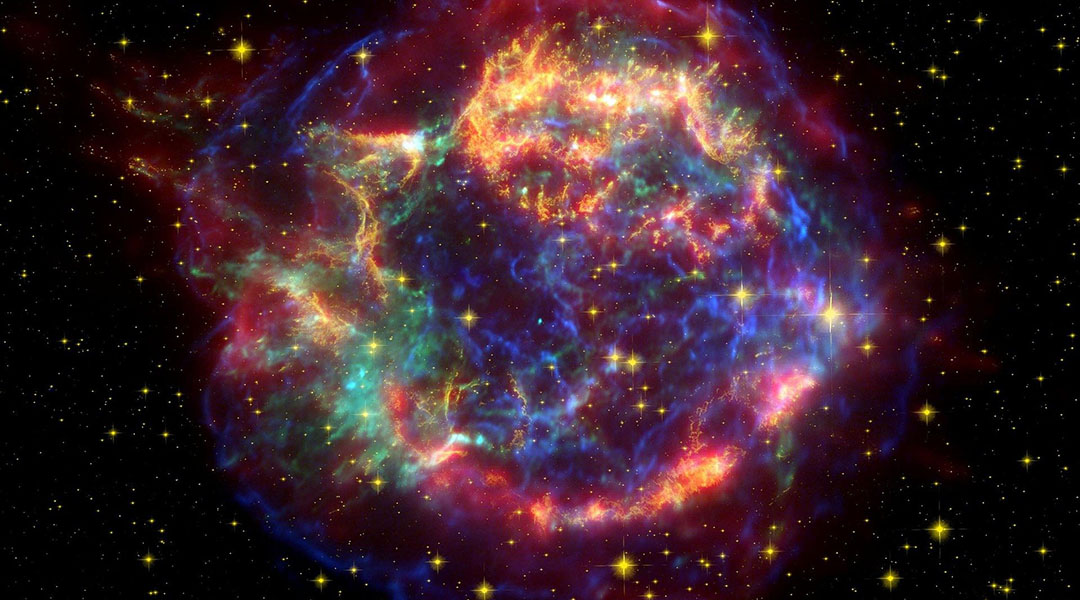Supernovae are wild explosions of massive stars or white dwarfs and are known to be among the most luminous objects in the Universe — some of them can be dozens of times brighter than all 100 billion stars in the Milky Way Galaxy combined. In addition to light emission, these explosions generate powerful fluxes of neutrinos and gravitational waves.
Supernovae are extremely interesting to astrophysicists as the features of the explosions are related to the details of the processes occurring within the interiors of the star before the explosion, which are currently not fully understood.
However, the supernova explosion itself is very difficult to detect, since the process is very transient. Thus, astrophysicists usually have to study the luminous remnants of an already exploded star, called the progenitor. To gain a better understanding of supernovae, it would be helpful to determine the signatures of an impending explosion and focus attention on the dying star before the explosion occurs.
Right before the explosion
This is exactly what a recent pre-print study by a team of astrophysicists, led by Daichi Tsuna of the Research Center for the Early Universe at the University of Tokyo, sought to do.
The study, which has not yet been peer-reviewed, based its analysis on the observation that many of the remnants of exploded stars are surrounded by matter too dense to fit into the generally accepted theoretical models of supernovae. The researchers decided to test the hypotheses put forward by other groups earlier that this matter was produced not during the explosion, but as a result of processes within the star that precedes it. They also suggested that these processes may have some observable signatures that can be used as precursors to a supernova explosion.
In order to verify the correctness of this idea, the team conducted computer simulations of the processes occurring in the outer layer of the star, called the envelope, which forms as it is about to explode. They suggest that when energy is injected into this layer from those below it — as usually happens in dying stars — matter erupts from it, the process of which has observable signatures that the astronomers can study.
The computer model of the star, whose internal dynamics were studied numerically, roughly corresponded to a real star of the red supergiant type. This type of star has the largest radius of any known type of stars, typically several hundred times that of the Sun, and a surface temperature of around 4000 K, about two-thirds the temperature of the Sun. The most well-known representatives of this class is the famous star Betelgeuse, which is expected to explode as a supernova in the near future.
What have researchers found?
The simulations showed that the researchers’ assumption was correct: the matter from the envelope erupts from this layer, which leads to the production of electromagnetic radiation. The model also predicted that this “pre-explosion radiation” could last hundreds of days before the star explodes, and that it is powerful enough to be detected by future infrared telescopes.
In addition, not only the duration of the radiation, but also its spectrum have quite definite features, which should make it possible to distinguish the radiation of a future supernova from other light sources in space.
Future studies
The authors of the study place their main hopes on the new ground-based Vera C. Rubin Observatory, which will operate in the range from infrared to ultraviolet light. The telescope is located in Chile, and is expected to begin full survey operations in October 2024. It will be able to conduct observations at much greater sensitivity than modern telescopes, and provide credibility to the author’s model.
If the scientists’ numerical analysis is correct and supernova explosions are indeed preceded by observable radiation with a certain spectrum, detecting this radiation will allow light, neutrino and gravitational observations to be coordinated before the explosion occurs in order to study it comprehensively. This will hopefully dramatically deepen our understanding of the structure of stars and their evolution.
Reference: Daichi Tsuna, Yuki Takei, Toshikazu Shigeyama, “Precursors of Supernovae from Mass Eruption: Prospects for Early Warning of Nearby Core-collapse Supernovae,” 2022, arXiv:2208.08256v1
Feature image credit: WikiImages on Pixabay

















